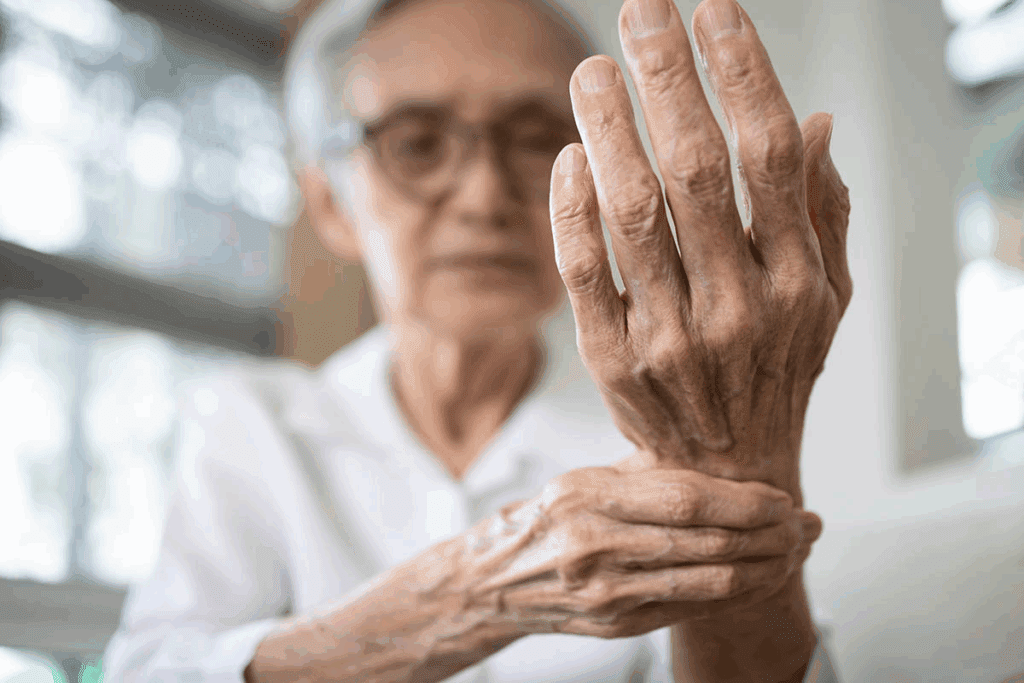Last Updated on November 4, 2025 by mcelik

Osteoarthritis is a disease that wears down joints. It affects millions globally. In the US, over 32.5 million adults live with it, says the Centers for Disease Control and Prevention. Find out the average age for osteoarthritis and what causes arthritis in young adults to develop early symptoms.
After 50, the chance of getting osteoarthritis goes up a lot. But it can hit people of all ages, making it a big health issue everywhere.
This disease causes cartilage in joints to break down. This leads to pain, stiffness, and less mobility. Knowing the average age of osteoarthritis helps find ways to prevent it.
Osteoarthritis affects joints in many ways. It causes cartilage to break down, leading to pain and stiffness. This condition is a big health issue, mainly for older people. But, it can also hit younger folks due to certain risk factors.
Osteoarthritis is a degenerative joint disease. It happens when cartilage in joints wears out. This results in bone rubbing against bone, causing pain and less mobility. The condition also changes the bone and tissues around the joint.
Osteoarthritis is not like inflammatory arthritis, like rheumatoid arthritis. It’s not caused by the body attacking itself. It’s more about wear and tear. Knowing the difference is key for the right treatment.
Understanding osteoarthritis and its unique traits is vital. It helps in managing and treating the condition effectively, even in young adults.
Knowing when osteoarthritis (OA) usually starts is key to catching it early. OA is a disease that wears down joints and gets worse with age. It affects people of all ages but is more common as we get older.
Research shows OA is more common in older adults. Most OA patients are between 40 and 65 years old. This age range includes many people who suffer from OA.
Several things can make you more likely to get OA, and these risks grow as you age. Some major risk factors include:
Between 40 and 60, joints start to change in ways that can lead to OA. These changes include cartilage wear, reduced space between joints, and bone spurs.
After 65, OA becomes much more common. Over 30% of people over 65 have OA. Women are more likely to have it than men.
In summary, knowing when OA usually starts and the risks involved is vital. It helps in early detection and managing the condition effectively.

Osteoarthritis is no longer just for the elderly. It’s now found in younger people, changing how we see age. We need to look closely at early onset osteoarthritis, what it is, and how common it is in different age groups.
Early onset osteoarthritis happens when people younger than usual get the disease. Traditional osteoarthritis is linked to aging and wear and tear. But early onset can be caused by genetics, injuries, or other health issues.
Osteoarthritis is more common in older adults, but it’s also rising in younger people. This shows we need to pay more attention to it in all age groups.
More people in their 30s and 40s are getting osteoarthritis. This calls for awareness and early treatment plans for this age group.
Osteoarthritis is becoming more common in people in their 20s. Sports injuries, genetics, and lifestyle choices are to blame. Early detection and management are key to preventing long-term problems.
The growing number of young people with osteoarthritis highlights the need to understand its causes and how to manage it. Healthcare providers must offer better care to all, regardless of age.
Arthritis in young adults can come from many sources. These include genetic factors and lifestyle choices. Knowing what causes it helps in preventing and managing it.
Genetics are a big factor in arthritis in young adults. If your family has arthritis, you might get it too. Scientists have found genes that raise the risk of osteoarthritis and other types.
Sports injuries and constant stress on joints can lead to arthritis. High-impact sports like football can damage joints over time. It’s important to train right, use the right gear, and manage injuries well.
Conditions like obesity and diabetes can cause arthritis. They lead to inflammation and harm joints. Hormonal changes, like in rheumatoid arthritis, can also affect the disease.
Birth defects or developmental issues can make young adults more likely to get arthritis. Problems like hip dysplasia or joint shape issues can cause uneven wear and tear. This increases the risk of osteoarthritis.
| Cause | Description | Prevention/ Management |
| Genetic Predisposition | Family history increases risk | Early monitoring, lifestyle adjustments |
| Sports Injuries | High-impact activities cause joint damage | Proper training, protective gear, injury management |
| Metabolic Disorders | Obesity, diabetes lead to inflammation | Diet, exercise, managing metabolic health |
| Anatomical Abnormalities | Congenital conditions affect joint health | Early diagnosis, corrective measures, monitoring |

Arthritis in your 20s is more common than you might think. It challenges the idea that it’s only for older adults. This myth can cause delays in getting diagnosed and treated in younger people. In truth, arthritis can hit anyone, no matter their age.
Studies show arthritis is common among young adults. For example, a study in the Arthritis Care & Research journal found 7% of adults with arthritis are under 44. Young-onset arthritis is also increasing, showing the need for early awareness and treatment.
Some key statistics include:
Many believe arthritis only affects older adults. But this ignores the various forms of arthritis that can strike younger people, like rheumatoid and psoriatic arthritis.
“The notion that arthritis is a condition of the elderly is outdated. We see more young adults being diagnosed, which highlights the need to understand the different types of arthritis and their risk factors.”
Young adults can get different types of arthritis, each with its own signs and causes. Knowing these differences is key for the right diagnosis and treatment.
| Type of Arthritis | Common Symptoms | Typical Age of Onset |
| Rheumatoid Arthritis | Joint pain, swelling, stiffness | 20-40 years |
| Psoriatic Arthritis | Joint pain, skin psoriasis | 20-50 years |
| Osteoarthritis | Joint pain, limited mobility | 40+ years, but can occur earlier |
By knowing the different types of arthritis and their signs, young adults can get medical help early. This can greatly improve their outcomes.
Arthritis isn’t just for older people. Young adults can get it too. Knowing the early signs is important for quick action.
Spotting arthritis early is key to managing it well. Young adults should watch for these signs:
These signs might mean you need to see a doctor. If you notice them, don’t ignore them.
Arthritis symptoms in young adults are not the same as in older ones. Young people might have milder or less frequent symptoms. This makes it harder to catch early.
It’s important to know these differences. This helps doctors and patients get the right treatment.
Acting fast is key to managing arthritis. Early treatment can ease symptoms and slow the disease. Young adults can try different treatments, like changing their lifestyle, physical therapy, and medicine.
Early action can greatly improve your future. It helps you stay independent and do what you love without trouble.
Getting a correct diagnosis of osteoarthritis in young adults is key to good care. It’s hard to spot in this age group because its symptoms can look like other health issues. So, a detailed check-up is needed.
Young people with osteoarthritis often have symptoms that are not clear-cut. These symptoms can be confused with other joint problems or injuries. Using a careful check-up and advanced tests is the way to solve this problem.
One big challenge is telling osteoarthritis apart from other arthritis types. Conditions like rheumatoid arthritis or lupus can look similar in young people.
Imaging and lab tests are very important for diagnosing osteoarthritis. Here are some common imaging methods:
| Imaging Technique | Description | Usefulness in OA Diagnosis |
| X-ray | Radiographic imaging to assess joint space narrowing and bone spurs. | Helpful for assessing the extent of joint damage. |
| MRI | Magnetic Resonance Imaging to evaluate cartilage, ligaments, and soft tissues. | Provides detailed images of joint structures, aiding in early detection. |
Lab tests, like blood work, are also key. They help check for signs of inflammation and rule out other diseases.
“The diagnosis of osteoarthritis requires a combination of clinical evaluation, patient history, and diagnostic imaging. Laboratory tests help rule out other causes of joint pain.”
— Expert in Rheumatology
It’s important to rule out other conditions that have similar symptoms. This includes inflammatory arthritis, infections, and other joint problems. A detailed diagnostic process is needed for a correct diagnosis.
For example, rheumatoid arthritis can look like osteoarthritis in young adults. So, it’s important to do thorough lab tests and imaging to tell them apart.
By using a mix of clinical knowledge and modern diagnostic tools, doctors can accurately diagnose osteoarthritis in young people. This helps in creating effective treatment plans.
Young adults with osteoarthritis need a treatment plan that fits their needs. This plan should cover both physical and lifestyle aspects of the disease.
For young adults, the first step is often conservative management. This method aims to lessen symptoms and improve life quality without surgery.
Physical therapy is key in managing osteoarthritis. It keeps joints moving and strengthens muscles. Exercise protocols are made for each person, focusing on low-impact activities like swimming or cycling.
Keeping a healthy weight is important for joints, like hips and knees. Nutritional support is also essential. Eating foods that fight inflammation can help manage symptoms.
If conservative methods don’t work, medication might be needed. The right medication depends on symptoms, other health issues, and what the patient prefers.
For some young adults, surgery is the best option. The decision to have surgery depends on joint damage and overall health.
Joint preservation aims to fix or stabilize the joint. This can delay more serious surgeries. Techniques include arthroscopic surgery or osteotomy.
Deciding on joint replacement surgery is big, even for young adults. It’s a choice that considers symptom relief and future surgery risks.
| Treatment Approach | Description | Benefits |
| Conservative Management | Includes physical therapy, weight management, and nutritional support | Reduces symptoms, improves quality of life |
| Medication | Used when conservative management is insufficient | Provides symptom relief |
| Surgical Interventions | Includes joint preservation techniques and joint replacement | Repairs or replaces damaged joints |
Disease progression in early-onset osteoarthritis varies a lot among people. It’s influenced by many factors. Knowing these factors is key to managing the condition well.
How fast osteoarthritis progresses can depend on several things. These include genetics, lifestyle, and other health issues. For example, those with a family history of osteoarthritis might see their disease get worse faster.
| Factor | Impact on Disease Progression |
| Genetic Predisposition | Increases the risk of rapid progression |
| Lifestyle Choices (e.g., exercise, diet) | Can slow or accelerate disease progression |
| Comorbid Health Conditions | May complicate management and influence progression |
Early-onset osteoarthritis can really affect your job and daily life. To manage it well, you can adjust your work space, exercise regularly, and keep a healthy weight.
Dealing with early-onset osteoarthritis can also affect your mind. You might feel anxious or depressed. Getting support from doctors, family, and support groups is very important.
By understanding what affects disease progression and using good management strategies, people with early-onset osteoarthritis can do better in the long run. They can keep a good quality of life.
Osteoarthritis can hit anyone, at any age. Knowing its causes, symptoms, and treatments is key to managing it well. Each age group faces different challenges and needs special care.
To tackle osteoarthritis, we need a full plan. This includes being aware, catching it early, and taking action. By knowing the risks, spotting symptoms early, and trying treatments, we can live better with the condition.
Handling osteoarthritis means making lifestyle changes, getting medical help, and staying on top of care. It’s also vital to spread the word about osteoarthritis. This way, we can catch it sooner and get better results. Together, we can make plans to manage osteoarthritis and improve our health.
Yes, arthritis can happen in your 20s. Osteoarthritis is more common in older people. But, young adults can get it too. This is more likely if you have a family history, have joint injuries, or have certain metabolic disorders.
The CDC says osteoarthritis can happen at any age. But, it gets more common as you get older. The average age for it to start is around 45-55 years old. But, it can start earlier or later for different reasons.
Arthritis in young adults can come from genetics, sports injuries, or repetitive joint damage. Metabolic disorders and certain body shapes can also play a part. Knowing these causes can help in preventing and managing it.
Osteoarthritis is a degenerative disease that breaks down cartilage and bone. Other types, like rheumatoid arthritis, are inflammatory. Getting the right diagnosis is key to managing it well.
Early signs of arthritis in young adults include joint pain, stiffness, and trouble moving. Spotting these signs early and getting medical help can prevent serious damage later.
Diagnosing osteoarthritis in young people is tricky. Doctors use medical history, physical exams, imaging tests, and lab tests. These help rule out other conditions.
Young adults with osteoarthritis might try physical therapy, lifestyle changes, or medication. Sometimes, surgery is needed. The best treatment often combines several approaches.
Joint space narrowing is a sign of osteoarthritis. But, early treatment and management can slow it down. In some cases, it might improve joint health. But, reversing joint space narrowing is not always possible.
To manage osteoarthritis young, stay proactive. Keep a healthy weight, stay active, and avoid joint damage. Working with a healthcare provider to create a treatment plan is key.
The outlook for early-onset osteoarthritis varies. It depends on disease severity, lifestyle, and treatment. With the right management, many can live well and slow disease progression.
Subscribe to our e-newsletter to stay informed about the latest innovations in the world of health and exclusive offers!